To return to memories of the SS 320,
click here.
To return to the main page of the S 320, click here.
Memories of
Süleyman KURUM, '73-'79
A Great Time On
The Boats!
I was a Turkish Navy Submariner Officer
in the Turkish Navy Submarine Fleet between 1973-1987. Then I left
the submarines, heading to other Navy activities...
1- 1973-1979 S 342 TCG Turgutreis (Ex- USS Bergall- SS-320) ---- ET (Electronic
Technician)
2- 1979-1980 S 335 TCG Burakreis (Ex- USS Sea Fox SS-402) ---- Mech.
Engineer-Mec.Lietunant
3-1980-1985 S 333 TCG Ýkinci Ýnönü( Ex- USS Corporal SS-346) ---- Mech. Eng.
Mech. Captain
I have so many great memories, stories and photos while doing these jobs.
I have many memories of serving on the TCG Turgutreis as an ET.
For example, did you hear things like this?
Diving... I found it was extremely dangerous to dive while going in
reverse...
Going deep... we laid down deep for escape training exercise... but when
the submarine did not rise from the deep... it was some dangerous hours!
(These are about my sweet girl Turgutreis (USS-Bergall)... see below section
titled: True Stories...
I was also on her when we participated in the Cyprus Peace operation in 1974.
Here's some pictures from my time on the boats...
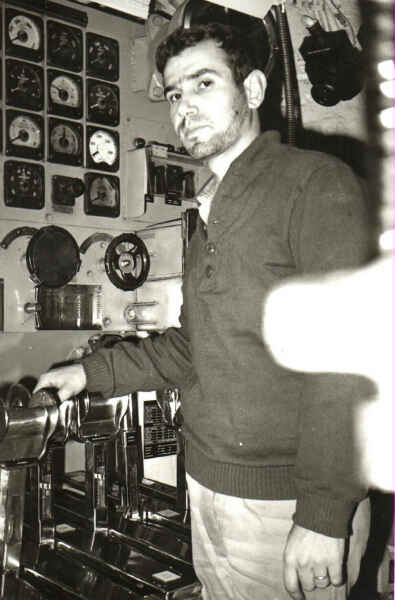
In the Turgutreis Maneuvering Room.. Checking controls..( 1975 )
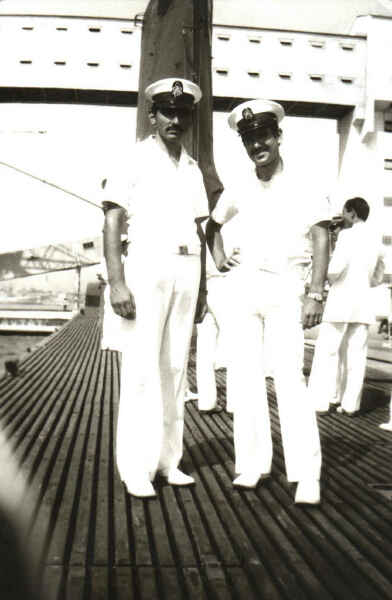
On the Aft Deck, Mersin Harbour, 1976 (Resting after Patrols for the peace
operation on Cyprus)
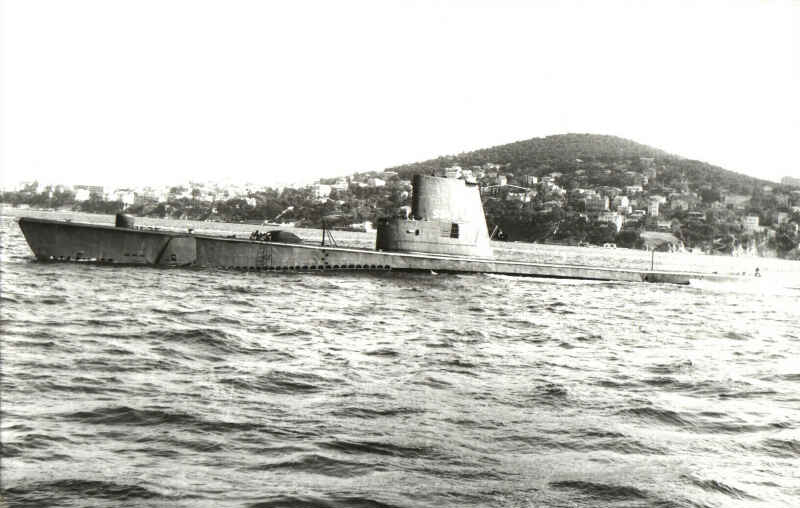
Turgutreis in front on the Princess Islands (Heybeliada) in Marmara (1975)
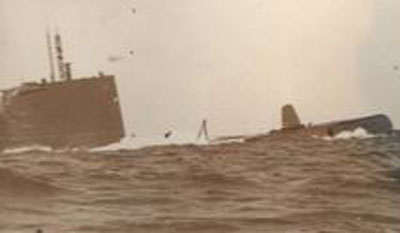
Surface Operation with 2.Ýnönü (1981)
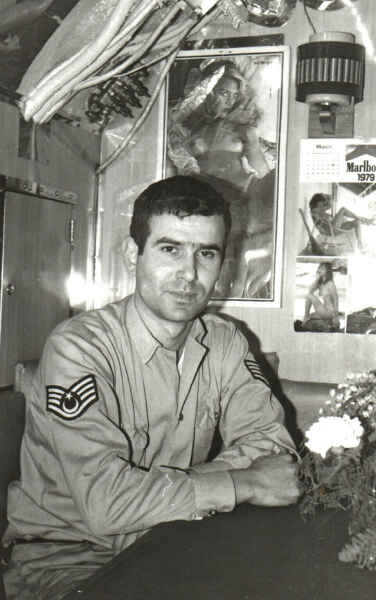
Resting in the Aft Battery Crew area with Playboy jolly wallpaper
(Turgutreis-1977)
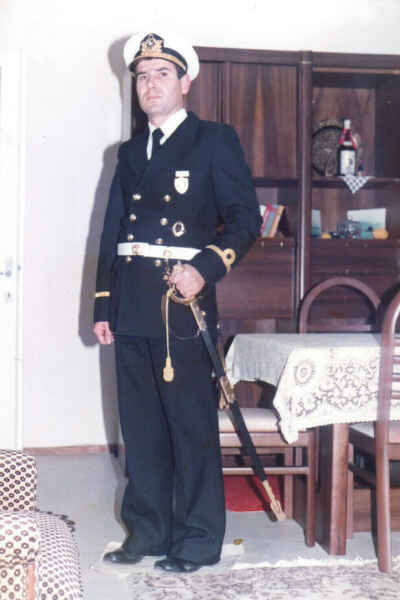
Going to the Naval Machine Engine School as a Lieutenant (1983)
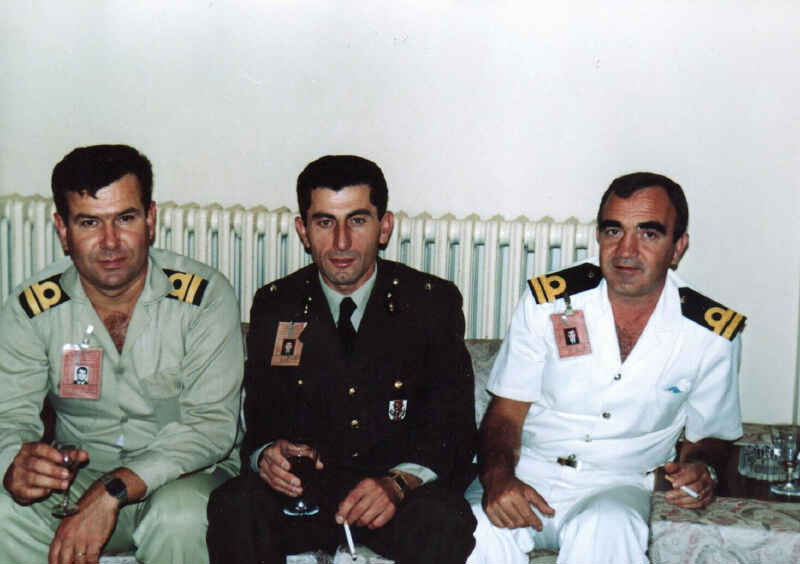
Resting during Happy Hour times with other Officer Friends as a Engineering
Captain ( 1989)
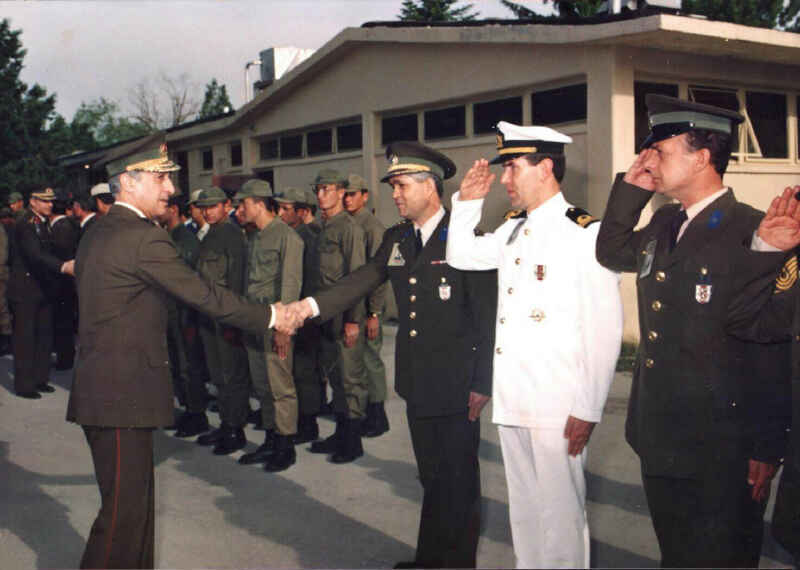
A Military days ceremony as a captain (1990)
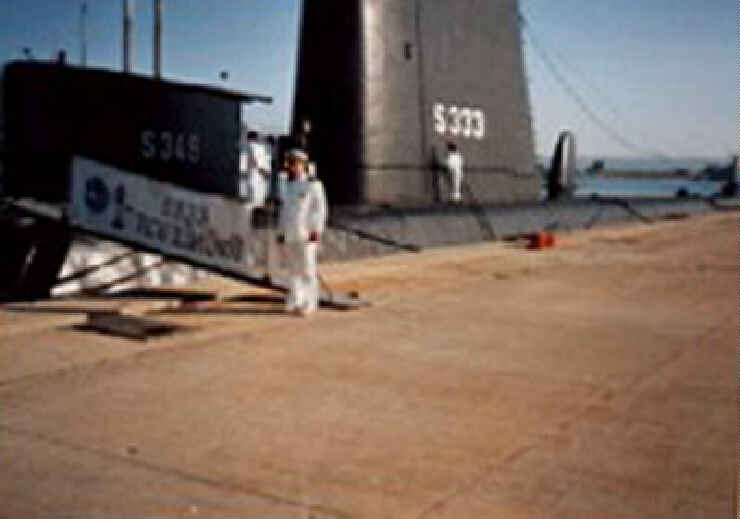
Front of the 2. Ýnönü as a Engineer Officer in Main Sub Base of Gölcük
(Lieutenant 1984 )
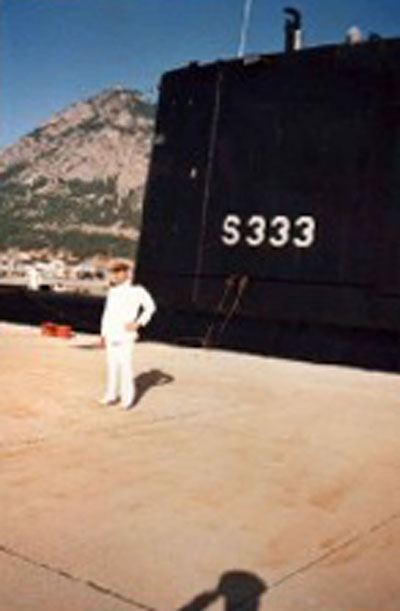
After an exercise in Alanya Harbour 1985 (Alanya is a shore city, south of
Turkey)
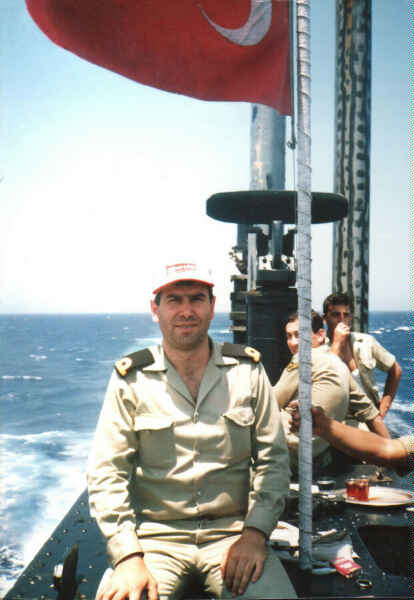
Top of the sail on a sunny day in the Mediterranean sea during a Nato
exercise..(1985)
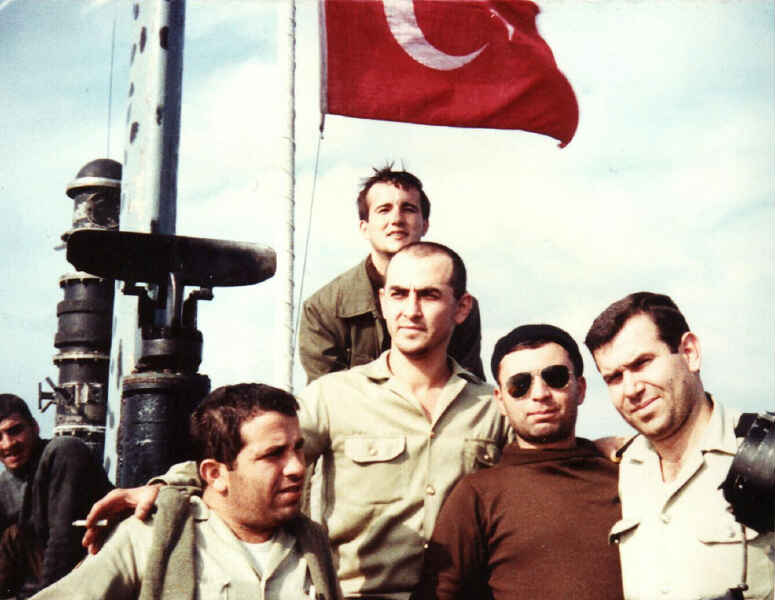
Same as above...
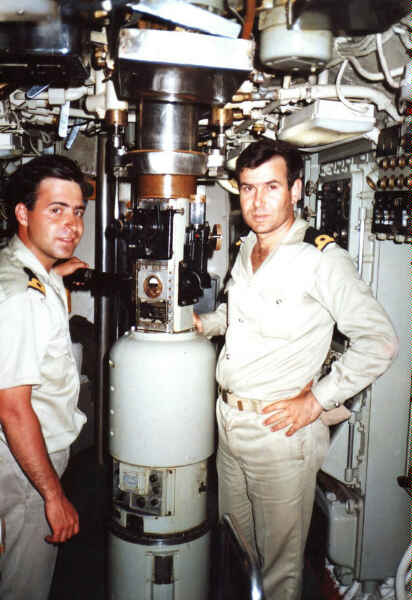
Same exercise, in the Conning Tower, Periscope duty in deep water...
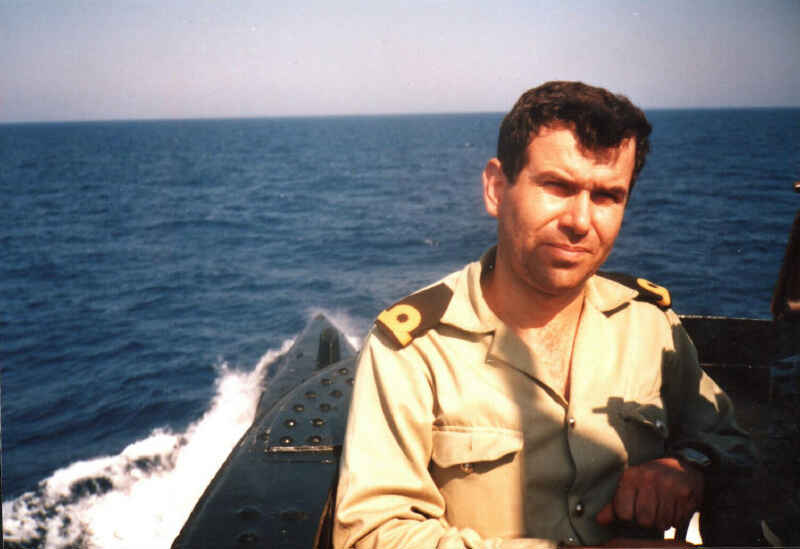
Same exercise,surface navigation...
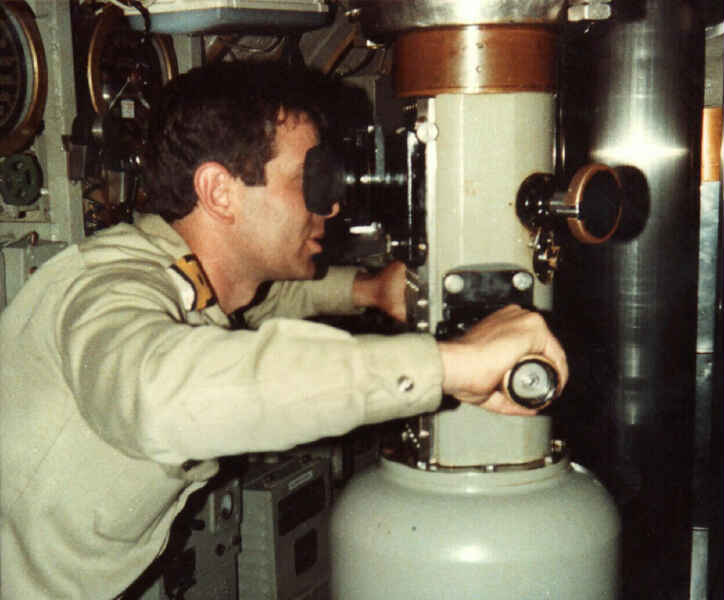
Same exercise, periscope navigation at 60 feet...
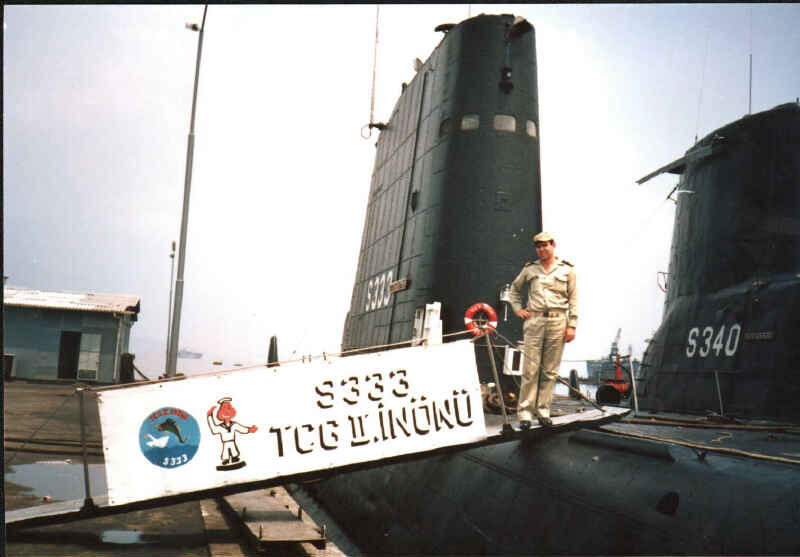
Main Sub Base with other Turkish submarine Cerbe (S 340) 1986.
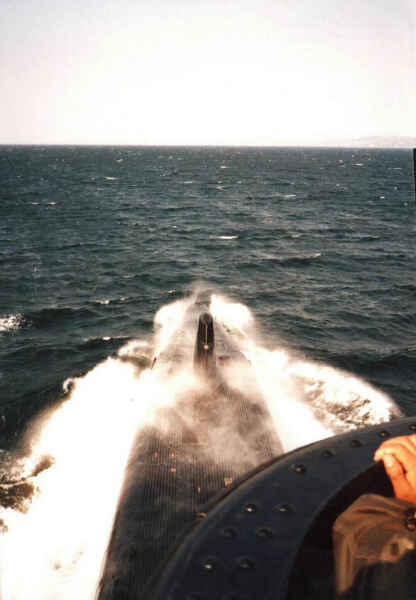
Passing the Dardanelles to Aegean sea on surface 1987
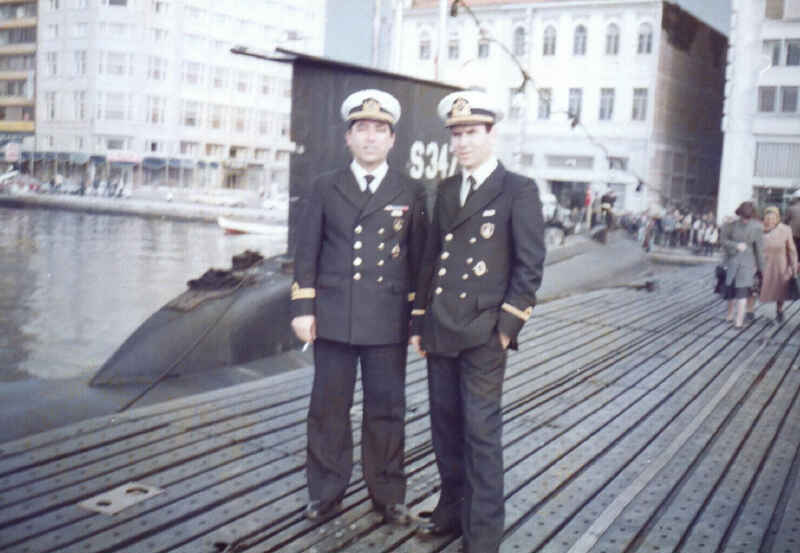
In Izmir Harbour with other Turkýsh Ay Class U209Submarine(S347) Atýlay-1986
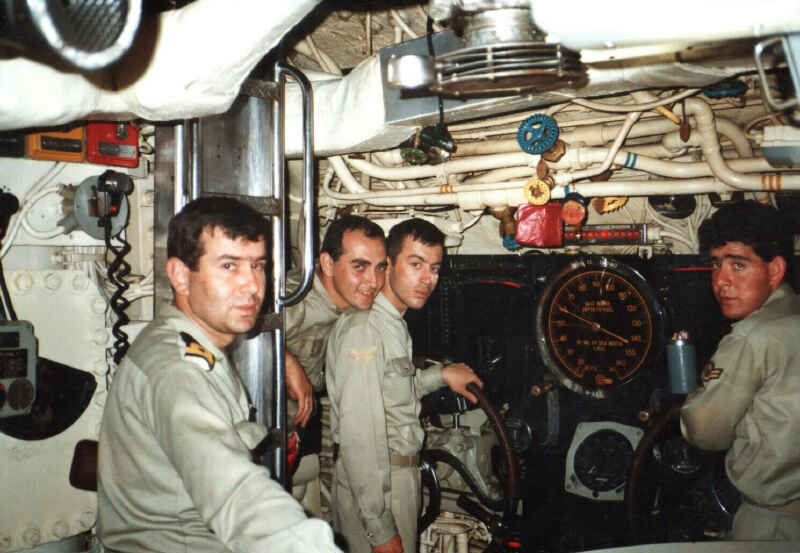
Horizontal Navigation in 60 feet...me with other diving control personnel..1985
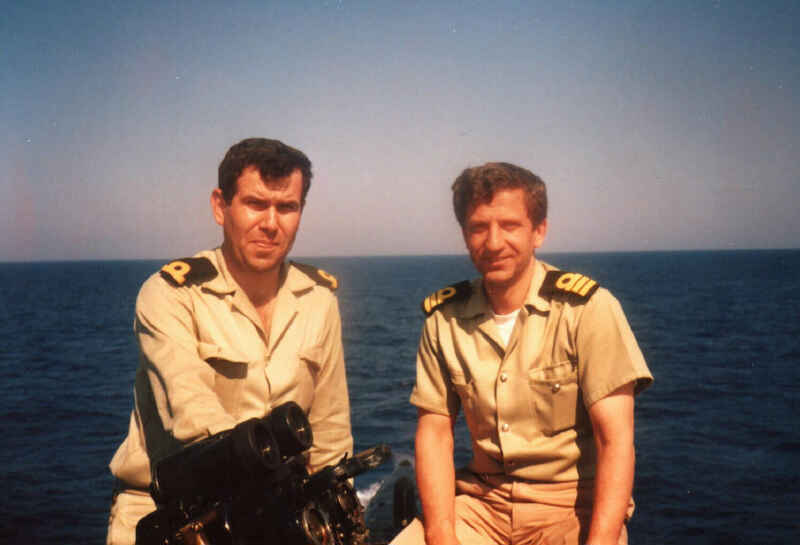
Me and my Commander Officer.. Surface Navigation in Aegean Sea...1986
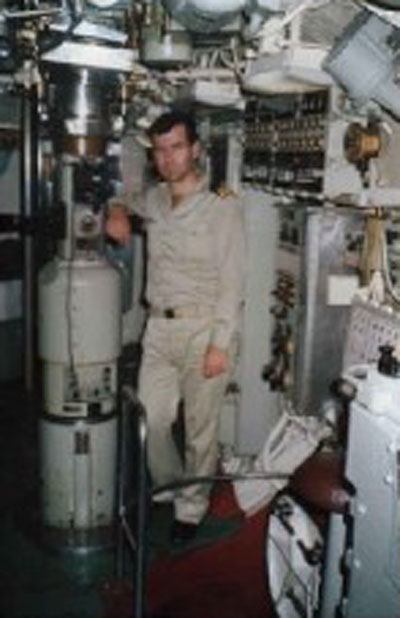
On the periscope duty.. undergoing training in 1983
I see that the webmaster has been in contact with Zafer Preveze
before. He was an Engineering Officer in another AY class Turkish
Submarine (Originally a U boat of Germany's 209 class). These are
supplied main electrical power by "Supplier Boats" (Ceryan Boats like Ex
Turgutreis) when in overhaul periods at the shipyard. Turgutreis was
in commission 13 years like this at the shipyard. And then she was
decommissioned in 1996. It is interesting that the Turgutreis and
nuclear Bergall went together, decommissioning both named sisters in the same
year Interesting...interesting...!!! It’s holy date for me...
I visited her during this period in the shipyard many times. I saw
the huge aquarium as described by Zafer Preveze. And my old ET Chief
Hasan ALP was on duty there, he already lived in Gölcük.
I was asked if I had a patch which related to her...I have a wall
shield honoring my duty years given to me. Here's what it looks
like.
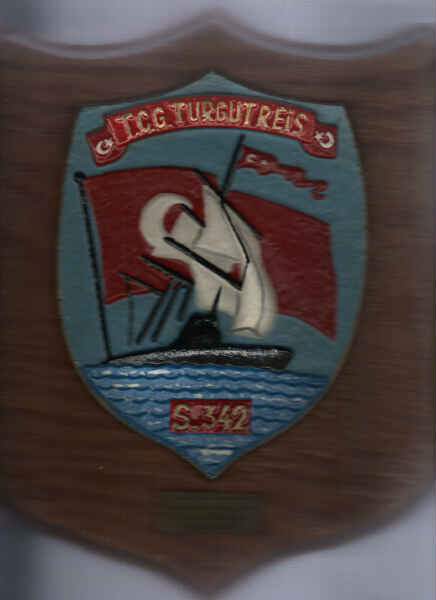
I'll research this patch for you. I’ll go to Gölcük to visit my old
chief and ask a lot of things like hearing that a Bergall crew member worked in
1968-1971 years with the Turkish Navy on the Turgutreis. It’s so
interesting for me. I did not hear about this man before.
Turgutreis came back to the USA in 1964 (as you know). At these
times our other submarines were going to the USA in systematic periods for
overhaul every 3 years because at this time the Turkish Navy Shipyards had no
submarine overhaul capabilities. In the next years we stopped this
procedure.
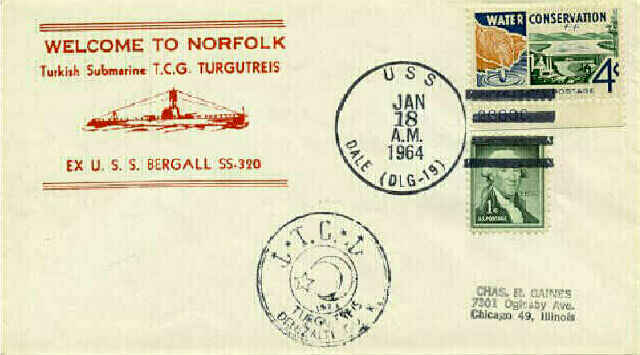 A ceremonial envelope.
A ceremonial envelope.
Diving, A True Story
Here's a true story about the Turgutreis from 1977.
It was the last week of a 6 week long review/training held at the end of
overhaul.
Our Flotilla Commodore was on the boat and the last tests were
finished. A trim dive was made and boat was fully trimmed. We
were on the surface and we had 2 hours of spare time.
Suddenly, a discussion was started in the Officers Rest Area during lunch time
about a new idea which had not been tried before... How to dive while
moving astern?
It had become a betting case between the Commodore and our
Commanding Officer. All of the operation would not be on
navigation records.
The Diving team held a meeting in the Control Room about how
to do this operation. These orders were given to each of the
steersmen, trim box and hydraulic operators in person. All crew were
at their positions of Battle Stations. SP phones were on heads.
1- Aft horizontal steersman would work
as the forward horizontal steersman and forward horizontal steersman would take
over the function of aft horizontal steer.
2- The Hydraulic operator would be
starting to open the air vents beginning from the aft site.
3- The Air bank operator would be put
in use #5 group air. (And at 3000 lbs )
4- The Main Steer would be under
control by second commander.
5- Diving operation would be lead by
the Chief Mechanic until the horizontal motion became normal and again on the
surface. etc.
I was the aft horizontal steer staff during this diving
operation.
Eventually the diving operation started. From the
1MC came: "Dive!.... Dive!...." Move astern half way with both
2 engines. Main induction valve was closed. Diving Board is green... OK...
Release air... Altimeter was fixed… Leak checks was perfect...
The boat was going astern, speedily...
Chief Mechanic
- "Open air vents!"... They are started to release from the
aft site first...
- "Keep 5
degrees with aft!" (To Forward horizontal steer)
- "To 60 feet
depth!"...(To Aft horizontal steer)
The boat started to dive with the impact of half reverse
engines and releasing air vents. 20 feet... 30 feet... 45 feet... "Empty
negative tank!"... 50 feet... Suddenly, diving gained extra speed... and
depth... 60... 70 feet...
However, Forward horizontal steersman was not able to fix the
diving slope of the boat at 5 degrees and the boat's angle kept
increasing….6….7…8…9…10… and gaining speed… 12…15…16…18…20… By the
way, 60 feet periscope depth was missed… 90 feet… 110 feet… 130… 150 feet.
The Control Room became a panic room….
At last, the Commander took control of the boat... "Aft
horizontal steer fully up!"... (It was already fully up)
Meanwhile, reverse speed and increasing depth was still
continuing… The breaking of plates and glasses was heard from
the kitchen. Everyone was holding anything they could…
It was running a very dangerous downhill, backwards!
180 feet was passed… with 22 degrees aft angle.
Chief mechanic - (To hydraulic
operator) "Shut the aft group air vents!"
- (To air
bank) "Get air to aft group!"
- (To
Maneuvering Room) "Stop the engines!... Full ahead with both two engines!"
- From 1 MC to
all rooms… "Shut the doors… Take precautionary measures of deep water…"
200 feet… 220 feet with 25 degrees aft angle…
There was panic in the Control Room but the Chief Mechanic,
Commander and Diving Team were imperturbable.
280 feet… 300 feet… At last, the boat was fixed at 315 feet
with 15 degrees aft angle… 14…12…10…
The boat was vibrating. With both engines working
loudly it was vibrating the boat.
Chief mechanic - (To aft horizontal
steersman) "Fix with 5 degrees aft angle!"
- (To forward
horizontal steersman) "To 60 feet!"
- (To
hydraulic bank) "Open the air vents!"
The boat headed to the surface finally. It
reached 60 feet with 5 degrees angle.
Everything started and ended in 5 minutes.
When we reached 60 foot the engines were taken from full ahead
to slow ahead and underwater motion became normal with some trim box operation.
Conclusion… Diving was successful. But very
dangerous aft slope and sudden flee to depth were not able to be understood.
It was observed that there was unordinary tension on crew for 5-10 minutes.
After 15 minutes, boat had reached the surface with normal operation.
Going Deep!
Autumn of 1978, end of September in Marmara Sea.
Rescue training whose the scenario was rescuing crew with a
rescue ship from a sunk submarine would be done. TCG Turgutreis was the most
proper and capable boat of placing on the bottom in the Turkish Submarine Fleet,
because her active sonar dome of boat had a flexible system. When this dome was
used it could be placed under the hull bottom or brought up inside of the boat
with the hydraulic system. There was not any salient part to be damaged at the
exact bottom of the boat.
D-Day... all preparations were completed and it started to
dive at the coordinate to be placed at bottom, which was decided before.
Coordinates were determined as sandy bottom and approximately 180-200 feet
depth, according to the map.
It was scheduled to dive at 08.00 AM. After making trim
tuning at 60 feet, the boat proceeded, with very slow way, to the coordinates to
be bottomed in the direction of bow. Sounding was actively reading the ocean
floor... 450 feet... 420 feet... 400...350...300...250...220... Stop
the engines! Fix with 2 headed! Filling up the tuning tanks she started down!
The depth gauge read 70 feet... 80 feet.. 90 feet...110 feet.. 120 feet...140
feet...150 feet... 160 feet... (depth sounding was 10 feet). The depth was 180
feet when the boat was shaken smoothly. The Turgutreis laid
down in the deep.
The depth gauge was fixed at 185 feet. The tuning tanks
were fully filled up. The negative diving tanks and safety tanks
were fully filled up. As if the boat cast laid down, anchored, the
starboard-port side slope was zero. We were in place, bottomed and very stable.
We communicated with the rescue ship with the underwater
phone. A data bullet was fired from the water artillery and a signal
buoy was sent up to the surface. In almost one hour the rescue ship
took position exactly above the boat by guiding on the signal buoy and the
rescue operation started.
After almost 3 hours of sitting on the bottom, the rescue bell
was engaged to the top of the forward torpedo room roller up hatch from the
rescue ship. By opening up the door, a diver from the rescue bell was
taken inside the boat. Four crew were in the first group taken to
the rescue ship by using rescue bell. This trip was made 6 more times
until evening. After the rescue bell left from the boat last time at
nearly 6.30 PM, the rescue ship left position by weighing anchor
Word was passed to prepare taking her off from the bottom in
15 minutes. First, excess weight in the tuning tanks were emptied by
the trim box operator. The negative diving tanks were completely
emptied. The horizontal motion officer first ordered to put air into the aft
ballast group, our angle was constant and there was no change. The
boat was set to start ahead on a forward heading. There was no motion.
Adding air was repeated. There still was no motion. All
tanks were given air. NO MOTION! Three group of air tanks
were emptied until dangerous low pressure limits were encountered. The
situation was relayed to the commander by the chief mechanic. The other two
groups of air were activated by order of the commander. Air was given to all
tanks with all groups again. The boat rattled and shook, however the depth
gauge was constant, 185 feet.
All the crew started to have stress and distinct anxiety,
there were many anxious faces. “Cut air!” Giving air was
cut. And the air groups were decreased considerably. The information
considering what was going on was requested from the rescue ship by using the
underwater phone because very large air bubbles were seen on the surface and
excessive turbid sea was seen by the rescue ship.
Circumstance evaluation was made and a dual action plan was
decided for the third and the last time. Both engines would be run astern with
half power by giving air from aft groups first, and the boat, firmly seated on
the bottom completely, would be taken off by scraping.
Discomposure and anxious faces become clear on the crew.
Time in fear did not pass.
Eventually, as expected, the last and final order came.
“Give air to aft group!”
Running astern with both engines with half way!
The boat was shaking. Powerful vibrations caused more fear.
Everyone held tight to anything they could reach.
The boat inclined towards its front side. 3 degrees headed...
4 degrees headed... 5 degrees headed.
“Give air to all tanks! Half way astern with both
engines!” The vibrations reached a more frightful situation.
Eventually the boat got off the bottom and began rising, 175 feet... 165 feet...
150 feet... 140 feet...
“Stop both two engines!... Slow way ahead with both engines!”
The boat was still for a moment and then made a charge forward.
(To steerers) “Fix aft angle at 5 degrees!” The boat
gained speed and it headed to the surface rapidly without control. The surface
horn buzzed. “Surface!.. Surface!...Surface!”
90 feet... 80 feet... 70... 60... 50... 40... 30... and
finally the surface.
“Run bellows and empty tanks!” And eventually we were on
the surface.
Joy screams and celebration sounds were heard on the
switchboard and the turret. When crew reached the bridge, a very
turbid scene was seen on the surface, spread to very large area of where we had
bottomed and this attracted the attention of crew.
We came back to the port and cast anchor.
Why did this happen? The keel and all sides of boat
were investigated by a diver requested from the rescue ship. No
damage was found.
Conclusion...It was now understood that the
coordinates which were placed for our bottoming training had a fabulously muddy
structure, like jelly. Because of the speed which the boat had
bottomed, the boat’s diving tanks were filled with mud during the bottoming.
Also, because of the sloppy floor, the boat was buried into mud up almost half
its height (more than 1/3 height). Even the mud tracks could be recognized
and cleaned from the deck when the boat was on surface.
Afterwards, these mud ruins were seen clearer and a thorough
cleaning was done when the boat came back to main base and subsequent dry dock.
Bottom training was not practiced at these coordinates anymore
and this kind of future training was held after careful investigation of the
floor structure at different locations.
I recently visited my old ET chief Hasan ALP in his home at
Golcuk.
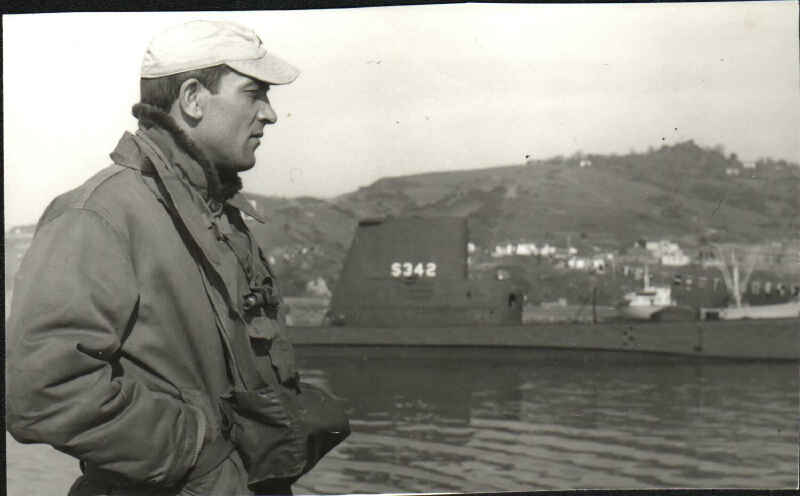
Here he is in Eregli Harbour in Black Sea together with her
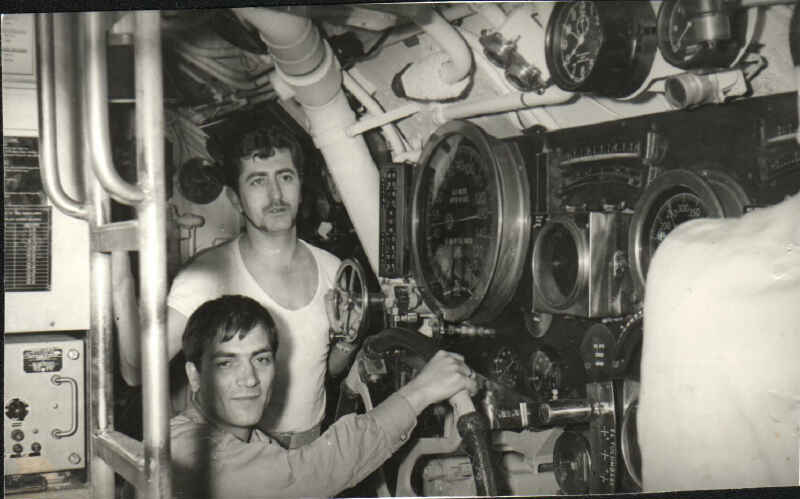
Here they are with the Turgutreis at a depth of 250 foot while in horizontal
navigation (carefully look at that depth gauge).
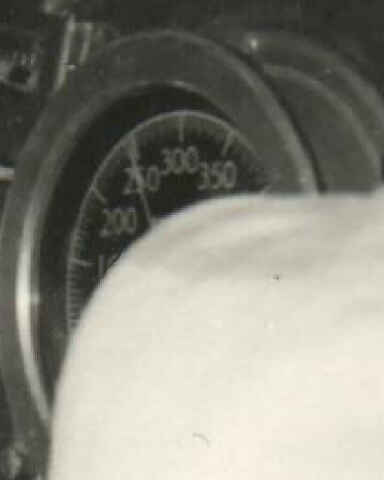

Here's his recent picture ...
His addres and phones datas is...
Hasan ALP
Yuzbasýlar Mah. 9.Sk. Yakamoz Apt. No:24/23
41950 Degirmendere-GOLCUK KOCAELI TURKEY
Home Phone :+90 262 4263686
I was there!... And I lived all scenes second by
second...
Süleyman KURUM
Ret.Mech.Eng.Capt./Turkish Navy
To return to memories of the SS 320,
click here.
To return to the main page of the SS 320, click here.






















 A ceremonial envelope.
A ceremonial envelope.


